With three major yet very different marathon sailing events crossing the Atlantic this month, it’s clear that the once decidedly quirky and often eccentric devotees of offshore and ocean racing are becoming mainstream. This is further reinforced by the confirmation – which has been flagged for a long time now – that World Sailing and the Olympics organisation will be evaluating an experimental two-handed and possibly gender-mixed offshore contest in parallel with the sailing events at the Tokyo 2020 Olympiad. W M Nixon wonders if long-serving offshore racing enthusiasts will really be a hundred per cent in support of these developments.
In sailing as in politics, ultimately everything is local. We’d always been interested in the Mini-Transat, but never more than the time when Enda O’Coineen did it rather longer ago than he cares to remember. And when the second stage of this year’s race got going from Las Palmas to Martinique on November 1st, the hearts of the Irish sailing community were with our folk hero Tom Dolan, the farmboy from Meath who has shown he can cut it with the best of them in this uniquely demanding branch of the ocean game.
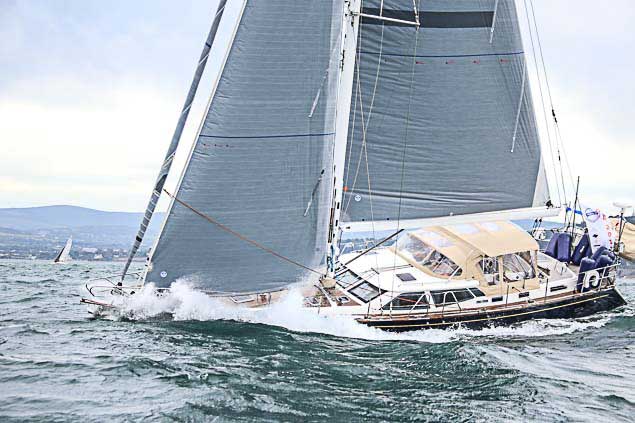 Never mind the weather, the tent is up and setting a treat…..Unlike the Mini-Transat boats which crossed the Atantic two weeks in advance of them, the crew of former Round Ireland winner Eamon Crosbie’s Discovery 55 Pamela will be enjoying considerable comfort during the ARC 2018. Photo David O’Brien/Afloat.ie
Never mind the weather, the tent is up and setting a treat…..Unlike the Mini-Transat boats which crossed the Atantic two weeks in advance of them, the crew of former Round Ireland winner Eamon Crosbie’s Discovery 55 Pamela will be enjoying considerable comfort during the ARC 2018. Photo David O’Brien/Afloat.ie
Then when the huge ARC 2017 got its incredibly varied fleet lumbering away last weekend, again from Gran Canaria, this time towards St Lucia, we tried to take an overview of the fleet, but inevitably became focused on Eamon Crosbie’s Discovery 55 Pamela from Dun Laoghaire with a merry crew on board. We’ve been observing that, like the rest of the fleet, she has found anything but regular northeast tradewinds out in the Atlantic, but she’s getting there nevertheless – race tracker here
This weekend, there’s some quite heavy metal – some of it distinctly luxurious in tone – getting started in the RORC’s Transatlantic Race from Lanzarote, with the finish in Grenada. The fleet of 23 make up in quality what it lacks in quantity, for though the smallest boat is the JPK 10.10 Jangada, the largest is Daniel Stump’s Southernwind 96 Sorceress, while the longest is Ludde Ingvall’s uber-skinny 98ft Maxi CQS from Australia.
It’s aboard this extraordinary yoke that Ireland’s Sailor of the Year 2013 David Kenefick, now 26, is sailing as skipper. In an acknowledgement to the sheer power and reach of the French sailing scene, the young Cork sailor had been declared “Rookie of the Year” in the Figaro Solo circuit in 2013, and to the surprise of some of the more traditionally-minded adjudicators, this was seen by the sailing public as more important than some major achievements within Ireland, so four years ago Kenefick became their Number 1.
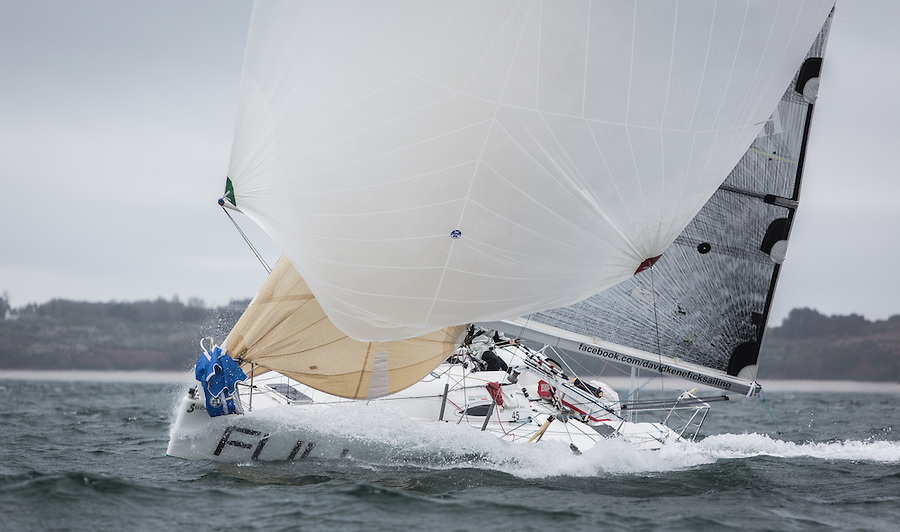 Somewhere in there on his Figaro Solo is David Kenefick, Ireland’s “Sailor of the year” 2013. Photo: Brian Carlin
Somewhere in there on his Figaro Solo is David Kenefick, Ireland’s “Sailor of the year” 2013. Photo: Brian Carlin
"Ludde is a legend and it is a great privilege to sail with him as skipper of CQS,” commented Kenefick. We have a young and multinational crew and we cannot wait to take on the challenge. CQS is a fantastic race boat and I am sure we are all going to learn so much after 3,000 miles.”
“In my early days I had the pleasure of racing with Harold Cudmore and we are still great friends,” said Ludde Ingvall. “I remember meeting with Harold and asking him what drives us on, now that we have been racing so many years. He replied we must 'pass it on' and that is what we are doing for young sailors that show great ability and the attitude to succeed.”
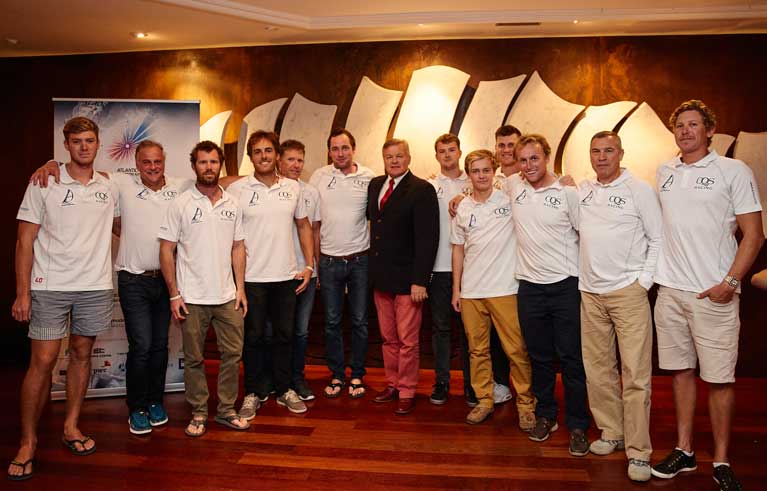 CQS crew – 26 year old Dave Kenefick pictured (centre) with Ludde Ingvall at tne gala dinner and his Australian 98ft Maxi CQS in the RORC Transatlantic Race starting from Lanzarote. Also pictured (fourth from left) is Royal Ulster Olympian James Espey
CQS crew – 26 year old Dave Kenefick pictured (centre) with Ludde Ingvall at tne gala dinner and his Australian 98ft Maxi CQS in the RORC Transatlantic Race starting from Lanzarote. Also pictured (fourth from left) is Royal Ulster Olympian James Espey
It will be intriguing to learn from one of our own just what it’s like to sail on something like CQS, which you can see as either counter-intuitive, or else so very intuitive that she has come out the other side. And with Kenefick on board, we will be keeping a special eye on her showing as the longest boat.
In between CQS and the “little” Jangada, there’s an eclectic selection including that old war horse, the Volvo 70 Monster Project (Roman Guerra). But generally they’re top end boats of comfortable size while being competitive at the same time. And with a considerable emphasis on European entries (there are boats from nine countries), they’re living proof that the story of the Eurozone’s economic recovery is true, and it’s out there and floating on the Atlantic.
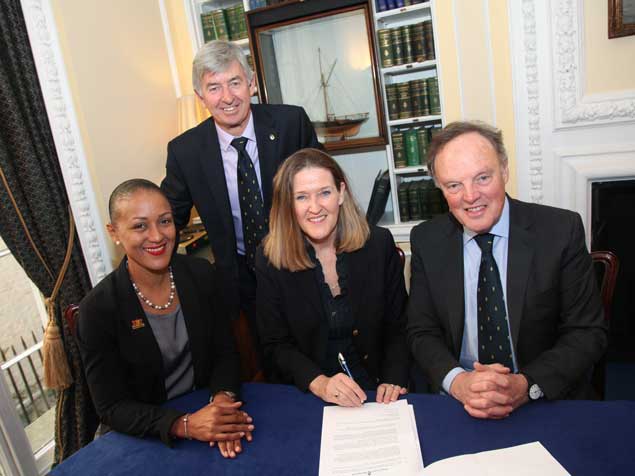 At the signing of the agreement to stage the RORC Transatlantic race from Lanzarote to Grenada are (left to right) Francine Stewart (Marketing Manager, Grenada Tourism Authority), Eddie Warden-Owen (CEO, RORC), Patricia Maher (Grenada Tourism Authority) and Michael Boyd (Commodore, RORC)
At the signing of the agreement to stage the RORC Transatlantic race from Lanzarote to Grenada are (left to right) Francine Stewart (Marketing Manager, Grenada Tourism Authority), Eddie Warden-Owen (CEO, RORC), Patricia Maher (Grenada Tourism Authority) and Michael Boyd (Commodore, RORC)
Typical of this is hyper-keen French owner-skipper Eric de Turkheim from La Rochelle, who we also feel is one of us, for if it hadn’t been for Rambler 88’s almost freakish performance in last year’s Volvo Round Ireland Race, his unusual-looking but effective Teasing Machine II would have been the overall winner.
Since then he has come up with the new 54ft Teasing Machine III, and though she wasn’t ready in time for the Fastnet Race in August, she made an impressive debut in the Middle Sea Race in late October, and would have been second overall if another of those pesky JPK 10.80s, this time the Russian-owned Bogatyr, hadn’t come out of the woodwork at the end, and snatched the win by six minutes, while Teasing Machine II was relegated to a close third overall.
So between CQS and Teasing Machine, we have favourites to follow. And although the RORC fleet start all of a week after the ARC, the winds along the sunshine route to the Caribbean are in such a wayward mood that it’s going to be fascinating comparing the relative performance of the two groups.
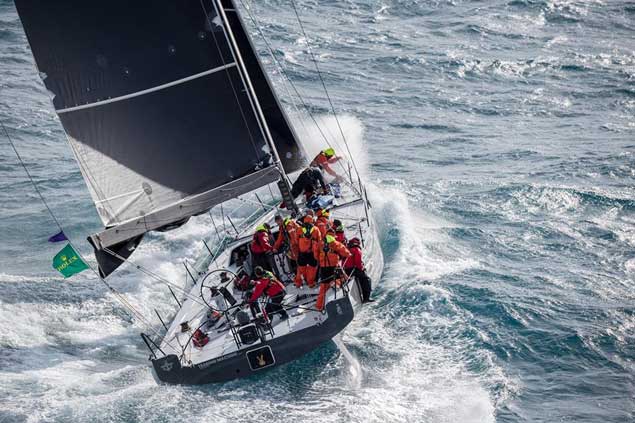 The new 54ft Teasing Machine II on her way to third overall in her first major event, the Rolex Middle Sea Race 2017. Photo Rolex
The new 54ft Teasing Machine II on her way to third overall in her first major event, the Rolex Middle Sea Race 2017. Photo Rolex
But what on earth, you might well wonder, is all this recitation of Atlantic voyagers and racers to do with giving only two instead of three cheers for the prospect of World Sailing shoe-horning offshore racing into the Olympics?
It’s simple. Offshore racing and its many organisations and events are so varied that trying to channel them into the narrow perspective of the Olympics, with its over-long four year cycle, is going to result in a very artificial construct. And the idea of having a man-and-woman crew of two who are declared to be the World Champions and Olympic Gold Medallists is so remote from the delicious, invigorating and multi-interest variety of the current offshore and ocean scene that we could be talking about two different planets.
For sure, it’s a notion which will appeal to newspaper headline writers. In the real red-top trade, sailing only makes sense when it’s in the Olympics or somebody is drowned. Beyond that, it’s simply too complex, varied and – let’s face it – self-absorbed, to promote itself as some sort of arena sport.
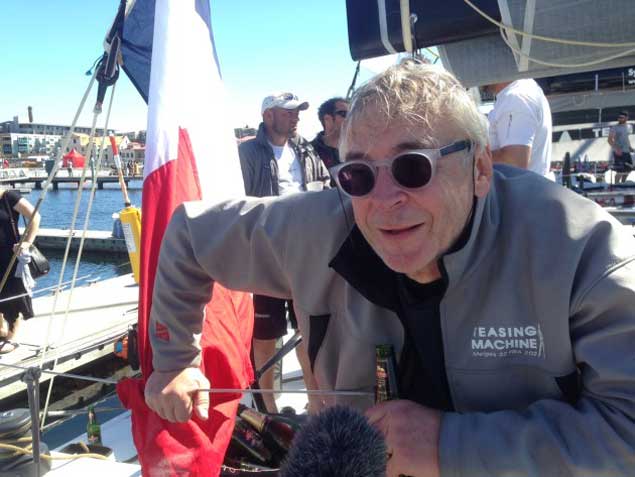 Eric de Turkheim, popular owner of Teasing Machine III, in Sydney preparing to race Teasing Machine II with success in the Sydney-Hobart Race
Eric de Turkheim, popular owner of Teasing Machine III, in Sydney preparing to race Teasing Machine II with success in the Sydney-Hobart Race
It was quite some time ago when two top honchos in American sailing announced that they were determined to reduce the number of world titles recognized by the then International Yacht Racing Union, which went on to become ISAF, and is now World Sailing. Back in the day, these guys reckoned that the 143 different IYRU-recognised classes with International status being each entitled to their own World Championship was a nonsense, and numbers should be reduced.
You can see why they thought so. One hundred and forty three sailing world champions might seem a bit over the top. But the idea went down like a lead balloon. People cherish their own classes, they cherish their own world titles, and they cherish their own local setup. And though they take a polite interest in World Sailing’s new look World Championship for Olympic classes, as it so often seems to be held on the other side of the world they’ll only engage if they happen to know of someone taking part.
So it’s complicated enough with inshore racing. But when you add in the extra factors involved in the much more complex and quirky world of offshore and ocean racing, it sometimes goes beyond understanding.
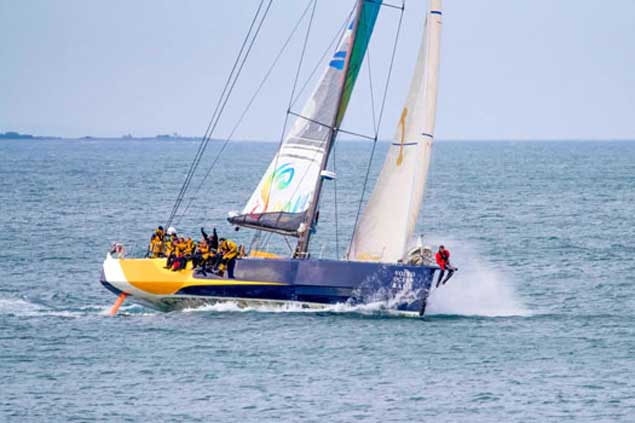 The old war horse. The Volvo 70 Monster Project coming to the finish to take line honours in the 2014 Round Ireland Race. She’s still going strong, and is one of the entries in the RORC Transatlantic Race. Photo WSC
The old war horse. The Volvo 70 Monster Project coming to the finish to take line honours in the 2014 Round Ireland Race. She’s still going strong, and is one of the entries in the RORC Transatlantic Race. Photo WSC
Yet the way things are provides something for everyone in the audience. While we pay lip service to approving the moves towards synchronising the IRC and ORC measurement systems, there’s a little bit of us that thinks it’s actually a pretty good idea having the two, as it allows for even more prizes, and they keep up the interest across a broader spectrum of the fleet.
Equally, an almost mind-numbing variety of events and organisations, a whole world away from the rigid one design format proposed for the Olympics offshore racing tryout, is what the global scene in the offshore game is all about. Think, for instance, of the 240 people from both sides of St George’s Channel who gathered at the Irish Sea Offshore Racing Association’s annual black tie dinner and prize-giving earlier this month in the National Yacht Club. All power to the great Peter Ryan for organising it, these were genuine sportsmen and women who are dedicated to their interest afloat, yet somehow trying to link them directly to the sterile world of the Olympics just doesn’t make sense.
At the other extreme, our own deservedly admired 2016 Olympic Silver Medallist Annalise Murphy instantly made herself much more interesting, much more of a three-dimensional character, when she courageously took on the crewing job aboard Turn the Tide on Plastic in the Volvo Ocean Race. There’s no doubt that having the fitness of an Olympic athlete is a real asset in a Volvo 65, but the concept of the Volvo Ocean Race is a million miles from Olympic theory.
In a different direction, sailing also includes the craziness of the America’s Cup, but in the offshore and ocean sphere, it’s generally agreed that the supreme event is the Vendee Globe. Nothing could be simpler in concept than one sailor on his or her own racing non-stop round the world out of a French port which finds it has stumbled on a world-beating event. Yet nothing is more complex than the actual machinations of the Vendee Globe, but the Olympic ideal it ain’t.
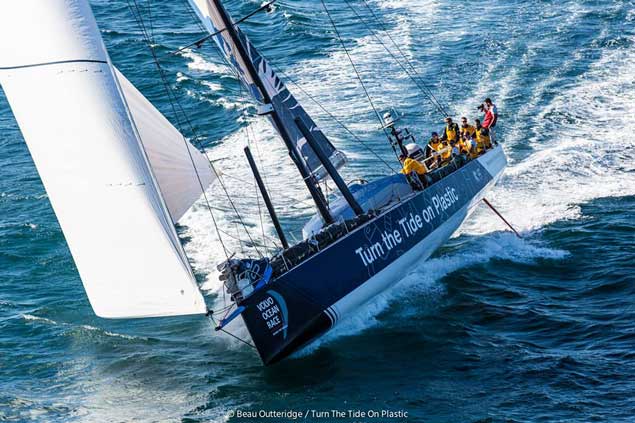 A very different machine from a Laser Radial – Silver Medallist Annalise Murphy is one of the round the world crew on turn the Tide on Plastic
A very different machine from a Laser Radial – Silver Medallist Annalise Murphy is one of the round the world crew on turn the Tide on Plastic
But despite these enormous difference, the fact of offshore racing becoming linked to the Olympics might make life a little easier for people like Tom Dolan who have literally re-invented themselves in the strange world of solo offshore racing, but find it extremely difficult to explain to non-sailors, especially those who might have a sponsorship budget, just what’s going on. However, mention the Olympics, and it’s a bit of a light-bulb moment.
That said, the proposed Olympic offshore course will be light years away from what Tom Dolan and his comrade-rivals put themselves through during the first 15 and more days of November. We carried an extract of winner Erwan Le Daroulec’s take on it earlier this week, but it’s worth repeating (and don’t sign off, the real meat of this week’s blog is at the end). Le Draoulac wrote:
“I brought a book with me, but I never thought to read it. I helmed, I ate, I slept, I answered the calls of nature, a real animal life. It was a nightmare.
The boat was soaked the whole time. I never dumped any sails, I just went up forward to reinforce my bowsprit. To get to sleep when I was under autopilot, I put on my headphones with some audio books and I listened again to the whole of Harry Potter. It was the only way of preventing stress whilst the boat was powering along at 18 knots, sometimes under autopilot, but I never eased off the pace.
It was only in the last two days where I dropped the large spinnaker in the squalls. I said to myself that it would be too silly to break everything so close to the goal. Prior to that though I really attacked hard. I knew I was risking a dismasting, but my line of thinking was that I was only twenty years old and that I’d have the opportunity to do another Mini-Transat. I didn’t make the most of it, I didn’t enjoy it. I’d like to the cross the Atlantic again, but gently so as to make the most of it.”
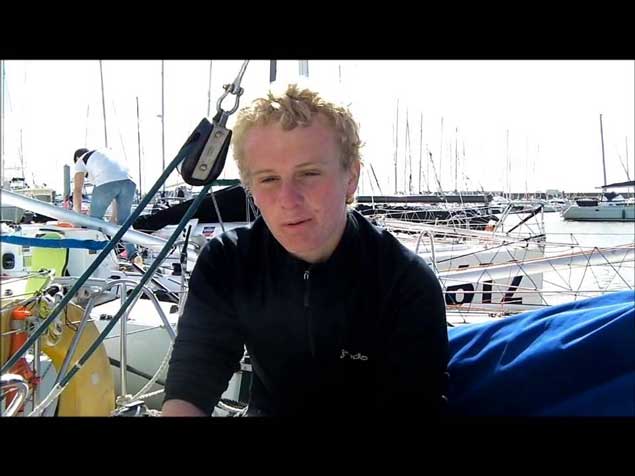 Erwan le Draoulec – he won, and won well, but says he didn’t enjoy it at all
Erwan le Draoulec – he won, and won well, but says he didn’t enjoy it at all
We really must try a dose of the old Harry Potters the next time insomnia comes along…..but seriously, what sort of a sailing world have we created, that a 20-year-old old is trained to such a level of performance that he can turn in an incredibly brave and skilled world-beating performance, yet actually hates every minute of it?
That said, Tom Dolan reckons he only feels truly alive when he’s “in the zone”, racing his little boat flat out. However, since he finished he has quietly revealed that, two days out from the finish, he survived an experience which was beyond fulfilling.
He was running in the dark in about 30 knots of wind and going a dream under the small spinnaker, nicely on track for fourth with a good chance of a bite at third, when out of the still-total blackness a 45 knot squall struck. IRL 910 went faster and faster, then a steep one lifted her from astern, and the tip of her stemhead went under the bow-wave. Within seconds, she’d done a complete pitchpole.
Tom found himself in the water in the dark, and his boat inverted for what seemed forever beside him. But she shook herself upright, he hauled himself aboard, and to his amazement everything, rig and all, still seemed intact. It was the first time he’d ever heard of a Min-Transat boat pitch-poling and not being dismasted, and miraculously it had happened to an under-funded Irishman who was campaigning on little more than wing and a prayer. He still had his wing. He will have sent have up a little prayer of thanks.
Then it was right back full on into the race, and we’ve all seen the vid of him finishing. But it’s worth repeating. You’re looking at a real hero.
He was within 48 minutes of being third and on the podium, but it was miraculous he was there at all. As for the final overall placings based on the total accumulated times for the two legs, the word is that won’t be officially announced until the Paris Boat Show on December 8th, when they’ll also stage the prize-giving.
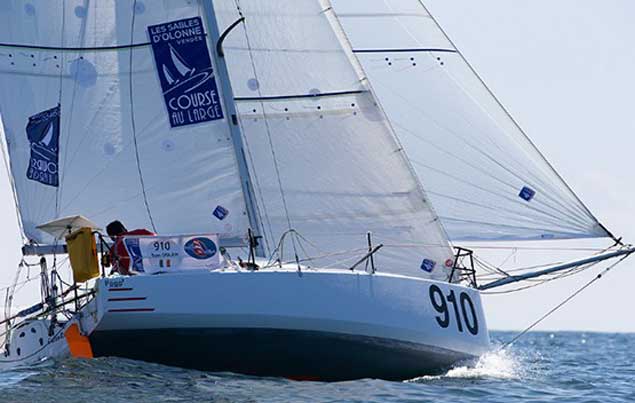 Tom Dolan with his new boat in 2016, when he won his first race. It has been revealed that he came fifth in the second leg of the Mini Transat despite being pitch-poled two days before the finish
Tom Dolan with his new boat in 2016, when he won his first race. It has been revealed that he came fifth in the second leg of the Mini Transat despite being pitch-poled two days before the finish
At the Paris Boat Show they’ll also officially announce the Golden Globe 18, golden oldies of a past era racing round the world in celebration of the Golden Jubilee the original Golden Globe, the non-stop round the world solo race of 1968 which was won by Robin Knox-Johnston in Suhaili. To be eligible, you have to be racing a “closed profile” (ie non fin-and-keg) boat of around 36ft, and Ireland’s Gregor McGuckin is entered with a Biscay 36 which he is currently preparing.
But as the organisers couldn’t get any British port associated with the original race to take it on fifty years later, Les Sables d’Olonne in France, home of the Vendee Globe, stepped up to the plate, and they will be the host port. It’s a perfect illustration of the huge spread of French interest in offshore racing. In fact, you might be making a sensible wager if you bet on France to support the new offshore event in the Olympics, but only if they can present the medals at the subsequent Paris Boat Show…
Meanwhile, as to Ireland being ready and willing for involvement in an Olympic offshore racing class, we certainly have plenty of keen young ocean racers, both men and women, who will be mustard keen if the resources can be found to get their campaigns under way. But as it is, the world of offshore racing is already rich in its diversity without being forced into any Olympic straitjacket. And that’s the way it is in Ireland too. We seem to like it that way too, but if the Olympics come calling, they’ll be welcome to join the party.
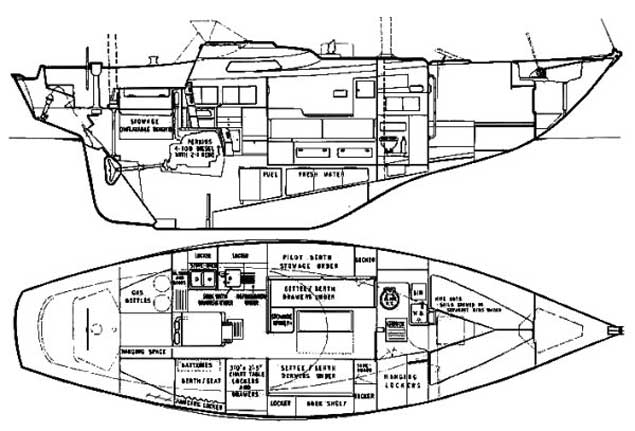 Tough and compact – the hull profile of a vintage Biscay 36. Ireland’s Gregor McGuckin will be racing one in next year’s Golden Jubilee of the Golden Globe Race. But despite the original having started and finished in England, the 2018 version will start and finish in France
Tough and compact – the hull profile of a vintage Biscay 36. Ireland’s Gregor McGuckin will be racing one in next year’s Golden Jubilee of the Golden Globe Race. But despite the original having started and finished in England, the 2018 version will start and finish in France
































































